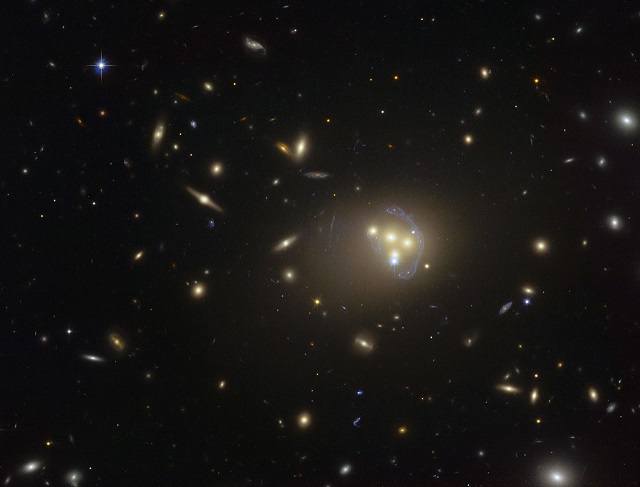
La materia oscura potrebbe essere, dopo tutto, non del tutto oscura – Per la prima volta la materia oscura potrebbe essere stata osservata in interazione con altra materia oscura in un modo diverso dall’attrazione gravitazionale. L’osservazione di galassie in collisione effettuata con il VLT (Very Large Telescope) dell’ESO e il telescopio spaziale Hubble della NASA/ESA hanno raccolto i primi interessanti indizi sulla natura di questa misteriosa componente dell’Universo.
Usando lo strumento MUSE installato sul VLT dell’ESO in Cile, insieme con immagini del telescopio orbitante Hubble, un’equipe di astronomi ha studiato la collisione simultanea di quattro galassie nell’ammasso di galassie Abell 3827. L’equipe ha potuto tracciare l’ubicazione della massa all’interno del sistema e confrontare la distribuzione della materia oscura con la posizione delle galassie luminose. Anche se la materia oscura non si vede, l’equipe ha potuto dedurne la posizione usando una tecnica chiamata lente gravitazionale. La collisione è avvenuta per caso proprio davanti a una sorgente molto più distante e non correlata. La massa della materia oscura intorno alle galassie in collisione ha distorto lo spazio tempo, deviando il percorso dei raggi di luce provenienti dalla lontana galassia di fondo – e distorcendone l’immagine nelle caratteristiche forme arcuate. La teoria corrente è che tutte le galassie si formino all’interno di grumi di materia oscura. Senza l’effetto vincolante della gravità dovuta alla materia oscura, galassie come la Via Lattea andrebbero a pezzi nella rotazione. Per evitarlo, l’85% della massa dell’Universo deve esistere sotto forma di materia oscura, eppure la sua vera natura rimane ancora misteriosa. In questo studio, i ricercatori hanno osservato le quattro galassie interagenti e hanno trovato che un grumo di materia oscura era apparentemente rimasto indietro rispetto alla galassia che circonda. La materia oscura è ora a circa 5000 anni luce (50 000 milioni di milioni di chilometri) indietro rispetto alla galassia – la sonda Voyager della NASA impiegherebbe 90 milioni di anni a coprire questa distanza. Un ritardo tra la materia oscura e la galassia ad essa associata è previsto durante la collisione se la materia oscura interagisce con se stessa, anche se debolmente, grazie a forze diverse dalla gravità. La materia oscura non è mai stata osservata prima d’ora interagire in modo diverso dalla forza di gravità.
Fonte/Leggi tutto → ESO.org
Dark matter may not be completely dark after all – For the first time dark matter may have been observed interacting with other dark matter in a way other than through the force of gravity. Observations of colliding galaxies made with ESO’s Very Large Telescope and the NASA/ESA Hubble Space Telescope have picked up the first intriguing hints about the nature of this mysterious component of the Universe.
Using the MUSE instrument on ESO’s VLT in Chile, along with images from Hubble in orbit, a team of astronomers studied the simultaneous collision of four galaxies in the galaxy cluster Abell 3827. The team could trace out where the mass lies within the system and compare the distribution of the dark matter with the positions of the luminous galaxies. Although dark matter cannot be seen, the team could deduce its location using a technique called gravitational lensing. The collision happened to take place directly in front of a much more distant, unrelated source. The mass of dark matter around the colliding galaxies severely distorted spacetime, deviating the path of light rays coming from the distant background galaxy — and distorting its image into characteristic arc shapes. Our current understanding is that all galaxies exist inside clumps of dark matter. Without the constraining effect of dark matter’s gravity, galaxies like the Milky Way would fling themselves apart as they rotate. In order to prevent this, 85 percent of the Universe’s mass must exist as dark matter, and yet its true nature remains a mystery. In this study, the researchers observed the four colliding galaxies and found that one dark matter clump appeared to be lagging behind the galaxy it surrounds. The dark matter is currently 5000 light-years (50 000 million million kilometres) behind the galaxy — it would take NASA’s Voyager spacecraft 90 million years to travel that far. A lag between dark matter and its associated galaxy is predicted during collisions if dark matter interacts with itself, even very slightly, through forces other than gravity. Dark matter has never before been observed interacting in any way other than through the force of gravity. Lead author Richard Massey at Durham University, explains: “We used to think that dark matter just sits around, minding its own business, except for its gravitational pull. But if dark matter were being slowed down during this collision, it could be the first evidence for rich physics in the dark sector — the hidden Universe all around us.” The researchers note that more investigation will be needed into other effects that could also produce a lag. Similar observations of more galaxies, and computer simulations of galaxy collisions will need to be made. Team member Liliya Williams of the University of Minnesota adds: “We know that dark matter exists because of the way that it interacts gravitationally, helping to shape the Universe, but we still know embarrassingly little about what dark matter actually is. Our observation suggests that dark matter might interact with forces other than gravity, meaning we could rule out some key theories about what dark matter might be.”
Source/Continue reading → ESO.org





















